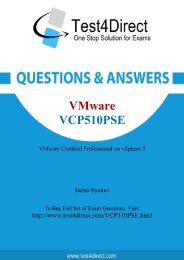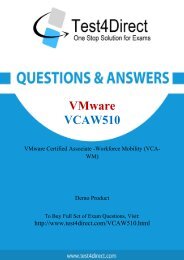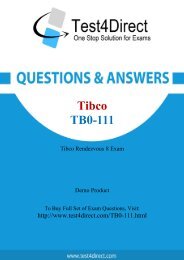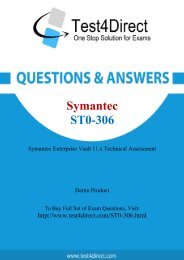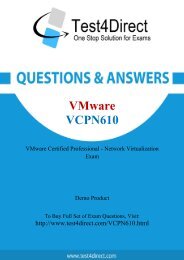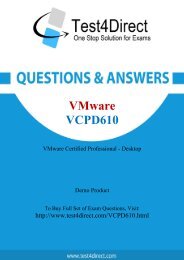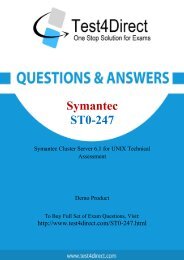VDCD510 Actual Exam BrainDumps
Test4Direct provides latest PDF questions of VMware VDCD510 exam. You have an opportunity to pass the VMware VDCD510 exam in one go. Test4Direct is most accurate source to prepare VMware VDCD510 exam as your success will become site’s responsibility after purchasing VDCD510 exam product. There are also lots of discounts and promotion offers that you can avail. Let’s try a free demo http://www.test4direct.com/VDCD510.html
Test4Direct provides latest PDF questions of VMware VDCD510 exam. You have an opportunity to pass the VMware VDCD510 exam in one go. Test4Direct is most accurate source to prepare VMware VDCD510 exam as your success will become site’s responsibility after purchasing VDCD510 exam product. There are also lots of discounts and promotion offers that you can avail. Let’s try a free demo http://www.test4direct.com/VDCD510.html
You also want an ePaper? Increase the reach of your titles
YUMPU automatically turns print PDFs into web optimized ePapers that Google loves.
VMware<br />
<strong>VDCD510</strong><br />
VMware Certified Advanced Professional - Datacenter<br />
Design <strong>Exam</strong><br />
Demo Product<br />
To Buy Full Set of <strong>Exam</strong> Questions, Visit:<br />
http://www.test4direct.com/<strong>VDCD510</strong>.html
Question: 1<br />
Entry criteria should be included in all areas of documentation designed for implementation and<br />
validation.<br />
A. True<br />
B. False<br />
Question: 2<br />
A validation plan should be based on estimated workloads and user behavior.<br />
A. True<br />
B. False<br />
Question: 3<br />
A validation plan is used to do which of the following? (Select all that apply.)<br />
A. Verify the design<br />
B. Verify that the system is functional<br />
C. Verify that the system meets requirements<br />
D. Meet current best practices<br />
Question: 4<br />
Question: 5<br />
Answer: A<br />
Answer: B<br />
Answer: A, B, C<br />
vSphere cluster functionality such as DRS and HA does not need to be part of a validation plan. This<br />
kind of documentation is only concerned with guest VM workload validation, not platform-wide<br />
validation.<br />
A. True<br />
B. False<br />
Answer: B<br />
The technical approach and order of delivery can have an impact on which of the following? (Select<br />
all that apply.)
A. Overall delivery time<br />
B. People resource contention (right person, right time, right task)<br />
C. Validation phase duration<br />
Answer: A, B, C<br />
Question: 6<br />
A project requirement _______________<br />
A. must be achieved<br />
B. can be set as aspirational but may never be achieved<br />
Question: 7<br />
Question: 8<br />
Question: 9<br />
Answer: A<br />
Explanation:<br />
A project requirement is a specific deliverable that the business has said must be provided at the end<br />
of a project. It must always be achieved.<br />
Chapter 4, Storage Design - The Logical & Physical Approaches<br />
A logical diagram shows vendor-specific information.<br />
A. True<br />
B. False<br />
Answer: B<br />
Explanation:<br />
A logical diagram shows the high-level components of a design or platform. It may include<br />
descriptions such as data flow and entity relationships. However, it does not show specific vendors<br />
(such as Dell or HP).<br />
Chapter 2, Creating the design<br />
Storage DRS is enabled by default.<br />
A. True<br />
B. False<br />
Chapter 4, Storage Design - The Logical & Physical Approaches<br />
Answer: B
Storage DRS can be enabled and can balance I/O levels based on _______________<br />
A. real-time stats<br />
B. historical stats<br />
Question: 10<br />
Question: 11<br />
Answer: B<br />
Explanation:<br />
Storage DRS can balance I/O by using storage vMotion. This would be based on historical values for a<br />
period of time. Storage DRS would make decisions based on these figures. If the system were using<br />
realtime stats, the machines could potentially migrate a lot more. This could have an effect on the<br />
latency figures for some systems. The larger historical sampling in storage DRS allows the system to<br />
make a decision with limited risk of impacting I/O—unlike moving a virtual machine over and over<br />
again.<br />
Chapter 4, Storage Design - The Logical & Physical Approaches<br />
The vCenter database is powered off ungracefully, along with a three cluster nodes in a separate<br />
cluster. Will the failed existing ESXi host nodes restart correctly using Auto Deploy?<br />
A. Yes<br />
B. No<br />
Answer: A<br />
Explanation:<br />
Auto Deploy enables an untrained IT professional to increase capacity while ensuring quality and<br />
consistency within a cluster. However, there is a dependency on the vCenter server and Auto Deploy<br />
server roles at different times. In this case, the ESXi hosts have already booted successfully. This<br />
means that all subsequent reboots will be controlled using configuration from the Auto Deploy<br />
server, not vCenter. If the vCenter database is impacted, the ESXi hosts will automatically restore.<br />
Even in the event of no vCenter availability, hosts will use the last-known copy of a distributed switch<br />
or the configured vSphere switch.<br />
Chapter X, Putting it all together<br />
A best practice can change over time.<br />
A. True<br />
B. False<br />
Answer: A<br />
Explanation:<br />
A best practice is based on experience with delivering a solution. A new product will have limited<br />
best-practice information except for vendor- or vendor-partner-based recommendations. The longer<br />
a technology is used in a community, the more potential success; therefore, best practices can<br />
change over time.
Chapter 6, Validation, Thoughts, and Processes<br />
Question: 12<br />
Only a software vendor develops a standard process or configuration.<br />
A. True<br />
B. False<br />
Question: 13<br />
Question: 14<br />
Answer: B<br />
Explanation:<br />
A best practice is based on experience with delivering a solution. A new product will have limited<br />
best-practice information except for vendor- or vendor-partner-based recommendations. The longer<br />
a technology is used in a community, the more potential success; therefore, best practices may be<br />
recommended by non-vendor-related people. It is up to a designer to validate this information<br />
rather than ignore it straightaway.<br />
Chapter 6, Validation, Thoughts, and Processes<br />
A logical design can contain which of the following? (Choose three)<br />
A. BIOS settings<br />
B. Data flow<br />
C. Key component relationships<br />
D. High-level diagrams<br />
E. Server host names<br />
Answer: B, C, D<br />
Explanation:<br />
A logical diagram can be used to show service components and how they relate to each other. A<br />
logical diagram is high level in nature and is independent of the hardware used for a solution.<br />
Chapter 2, Presenting the Data Gathered<br />
You are a VMware architect employed to design and build application environments and the<br />
underlying platform for a software development company. The company is using a “devops”<br />
approach and has engaged with you at the beginning of the first planning meeting/pre-sprint.<br />
The software has yet to be written. However, you have some high-level specifications that are subject<br />
to change at each of the early meetings. The ______ is more logical for virtual machine sizing.<br />
A. predictive sizing approach based on current software<br />
B. adaptive sizing approach<br />
Answer: B
Explanation:<br />
There are two types of scaling approaches in virtual platforms: adaptive and predictive. Both<br />
approaches are usable; however, a designer must work out which is the best approach for each<br />
project.<br />
The adaptive approach to guest virtual machine design is a major advantage that virtualization<br />
technology brings to a datacenter. It allows a guest virtual machine to be created initially on a few<br />
metrics or high-level requirements (such as a limited budget) and scaled (that is, grown, not shrunk)<br />
through the virtual machine life cycle. In many cases, this scaling can be performed hot/live without<br />
outage/downtime to the running applications.<br />
The predictive approach, on the other hand, requires more planning and research, and you must<br />
know the metrics before deployment. The advantage here is that once the virtual machine has been<br />
deployed, only application maintenance is required. The application requirements are known.<br />
Chapter 5, Design Approaches<br />
Question: 15<br />
You are working on a hybrid cloud project, where production applications (yet to be fully developed)<br />
are to be deployed. Which of the following is a project requirement?<br />
A. The production data must be in the UK at all times.<br />
B. The hosting partner provides sufficient resources without overcommitment to support application<br />
load.<br />
C. The hosting provider meets uptime expectations.<br />
D. The development team provides the software on time.<br />
Question: 16<br />
Question: 17<br />
Answer: A<br />
Explanation:<br />
A requirement is a definable and measurable project item. It must be part of the delivery, and its<br />
removal cannot be justified.<br />
Chapter 2, Definitions of Key Terms<br />
In the project life cycle, the ____________ defines the vision.<br />
A. IT architect<br />
B. software vendor<br />
C. business<br />
Answer: C<br />
Explanation:<br />
By reviewing the current configuration of a system and mapping the final status of components as<br />
described in the vision, the business identifies the gap between the two. A gap state analysis is a<br />
review of the items or tasks that are required to progress between the stages. Such an analysis is<br />
useful in creating milestone plans, implementation orders, and so on.<br />
Chapter 2, Gathering Information and Spotting the Gaps
A(n) _____________ is an item that is taken to be true in the design phases but has not been tested<br />
prior to execution.<br />
A. requirement<br />
B. constraint<br />
C. assumption<br />
D. risk<br />
Question: 18<br />
Question: 19<br />
Answer: C<br />
Explanation:<br />
An assumption could impact your design. It is good to ensure that project team and wider business<br />
are aware of assumptions and that they are agreed and validated as part of the design consideration<br />
process.<br />
Chapter 2, Gathering Information and Spotting the Gaps<br />
You are a virtualization consultant working on a DR project. You have proposed a solution that uses<br />
SAN replication technology to replicate production virtual machine files. This meets the cold standby<br />
requirement. Which of the following could be a design constraint?<br />
A. The hardware currently being used in the datacenter is out of support.<br />
B. The company is undecided about the choice of centralized storage to be used in the enterprise.<br />
C. The company is at the end of year 1 of a 3-year contract for the point-to-point link between Site A<br />
and Site<br />
B. This link is currently 10 MB.<br />
Answer: C<br />
Explanation:<br />
An item from the current state analysis that would restrict or change a design choice is potentially a<br />
constraint. Such factors can limit a design and in some cases prevent the realization of a project<br />
vision.<br />
Chapter 2, Gathering Information and Spotting the Gaps<br />
You are a technical consultant designing a solution for an online retail company. The project vision is<br />
to deploy a hybrid cloud, with the internal team developing the website on internal infrastructure<br />
and migrating production-ready applications to a hosting provider. The project is expected to ease<br />
deployment and require less infrastructure capital expenditure—without lowering application<br />
quality.<br />
Which of the following is a risk to the project?<br />
A. The solution must adhere to ISO 27001.<br />
B. Change control of the hosting vCloud platform is not under full control of the internal business.<br />
C. The hosting provider outsources the platform support to the platform vendor.<br />
D. The applications to be deployed on the production hosts are not fully developed, although a beta
exists.<br />
Question: 20<br />
Answer: B<br />
Explanation:<br />
The technical design process enables the platform designer to work in a methodical way and with<br />
others who have similar objectives. A risk is that a project item could potentially prevent the vision<br />
or aspects of it (requirements) from being created.<br />
Chapter 1, The Technical Design Process<br />
A DR project requires a recovery time objective (RTO) of 4 hours and has a recovery point objective<br />
(RPO) of 2 hours. The system fails at 8 p.m. on a Sunday evening. At what time is the application<br />
expected to be available to the end users?<br />
A. Midnight<br />
B. 10 p.m.<br />
C. 2 a.m.<br />
D. 11 p.m.<br />
Answer: A<br />
Explanation:<br />
The recovery time objective (RTO)—also known as the return to operation—is the amount of time it<br />
takes to restore a service after a failure has taken place. The recovery point objective (RPO) is the<br />
point in time to which the system needs to be restored following a failure.<br />
Chapter 3, RTO, RPO, and All That Stuff?
THANKS FOR TRYING THE DEMO OF OUR PRODUCT<br />
Visit Our Site to Purchase the Full Set of <strong>Actual</strong> <strong>VDCD510</strong> <strong>Exam</strong> Questions With Answers.<br />
http://www.test4direct.com/<strong>VDCD510</strong>.html<br />
We Also Provide Practice <strong>Exam</strong> Software That Simulates Real <strong>Exam</strong> Environment And Has<br />
Many Self-Assessment Features. Download Free Product Demo From:<br />
http://www.test4direct.com/<strong>VDCD510</strong>.html<br />
Money Back Guarantee<br />
Check Out Our Customer Testimonials




